Painting a fence can sometimes feel like quite a labour intensive task, but the finished results speak for themselves. A freshly painted fence can be transformative and provide your tired garden with some much needed TLC.
Discover our expert fence painting tips below to get the best results.
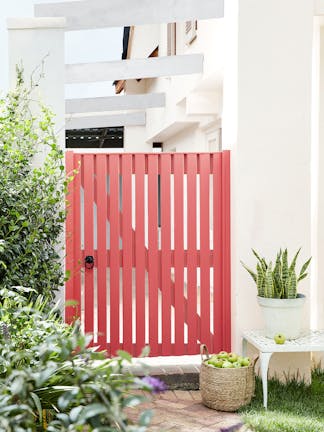
What is the best paint for fences?
Use our robust Intelligent Exterior Eggshell to ensure your fence will look beautiful for longer. This water-based paint is ideal for exterior wood, providing much needed protection from the elements. It’s also self-priming which means you can apply the paint directly onto bare wood.
Garden Gate: Orange Aurora
Walls: Hollyhock
Table and Plant Pot: Joanna
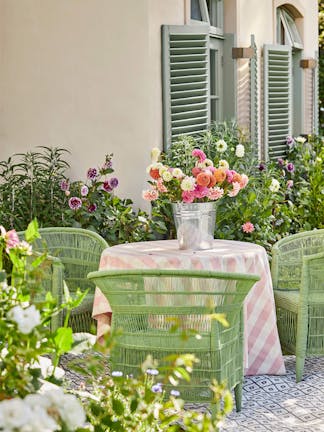
Explore the qualities that make Intelligent Exterior Eggshell the ideal finish for painting fences…
• Available in all Little Greene colours
• Virtually odourless
• Washable, weather resistant and durable
• Formulated to inhibit mould and algal growth
• Quick drying; touch dry in 2-4 hours and ready to re-coat in 16 hours
• Low sheen (15%)
• Available in 2.5l & 1l tins
How to Choose a Fence Colour
When choosing a colour for your garden fence, consider whether you want to add impact with a bold accent shade or coordinate with other elements for a cohesive scheme. Bright and vibrant shades like Orange Aurora or Mister David can transform a functional garden gate into a statement feature. Alternatively, paint your garden fence in deep, natural greens such as Puck or Harley Green for a scheme that blends seamlessly into the surrounding foliage.
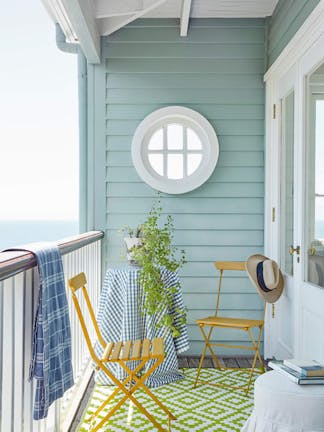
Some of our favourite colours for garden fences include:
- Invisible Green - this dark green was recommended for fences and railings by the landscape gardener Humphry Renton. Its rich hue beautifully complements background vegetation.
- Bone China Blue – Mid - a wonderful 1930s blue, this charming shade will create a timeless backdrop in your garden for a truly elegant scheme.
- Shirting - this pure white is based on natural materials, so it sits comfortably in outdoor settings. Try similar bright, heritage whites to achieve the classic, white picket fence.
With all Little Greene colours available in Intelligent Exterior Eggshell, you can choose the perfect shade to suit your own personal style. Request a colour card to explore the full palette.
Read our guide to using exterior paint coloursA guide to painting a wooden fence using Intelligent Exterior Eggshell
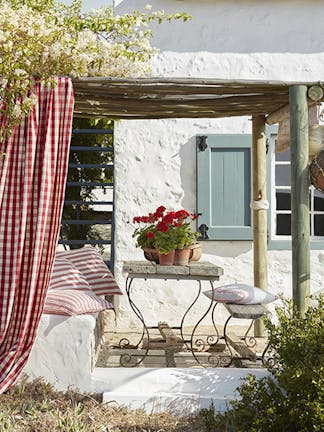
What you need to start your fence project
- 1 large paint brush
- 1 smaller paint brush
- 1 tin of Intelligent Exterior Eggshell in a colour of your choice
Use the larger paint brush for coverage and the smaller brush for targeting hard to reach places on the fence panel.
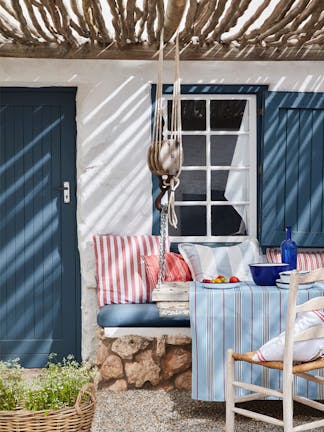
How to Prepare a Fence for Painting
- Ensure that the fence surface is cleaned.
- Previously painted woodwork must be thoroughly sanded, removing any loose or flaking paint.
- Before commencing the project, ensure the wood is completely dry. Damp wood should never be painted.
- To avoid paint spills on the grass or exterior flooring underneath your fence, lay down some dust sheets.
- For drastic colour changes or painting onto bare wood, we recommend applying one coat of Intelligent ASP (All Surface Primer). This will help you to achieve your desired colour with fewer topcoats, as well as priming the surface ready for painting.
Step-by-step Instructions for Painting a Fence
- Stir the paint thoroughly before use.
- Evenly apply the first coat of Intelligent Exterior Eggshell.
- Allow the paint to dry. Your fence panel will be dry to the touch within 2-4 hours. However, you will need to wait 16 hours before applying the second coat.
- Apply a second coat of Intelligent Exterior Eggshell in the same way. We recommend two full coats of Intelligent Exterior Eggshell to achieve full depth of colour.

Additional tips for painting a fence
- Start your fence project when you have a series of dry days, as damp wood should never be painted.
- If your fence has separate panels, we recommend pulling the panels out of their posts and painting them individually for ease. Allow the panels to dry before slotting them back in.
- If the fence isn’t detachable, ensure any surrounding foliage is cut back or gently pulled away before painting.
- For a smooth, professional finish use a large, high quality synthetic bristle brush. New brushes should be washed in clean water and thoroughly dried with a clean, lint free, cloth before use.
- Paint the fence panels in smooth, even strokes in the direction of the grain, rather than against it.
- Consider coordinating your garden fence with painted exterior walls. Read our guide to painting outdoor masonry for more specific guidance.
Wall: Obsidian Green
Discover our wide range of colours and learn more about the properties and benefits of the Intelligent Exterior Eggshell.
Or, browse our exterior inspiration gallery for more ideas to transform your outdoor space.

